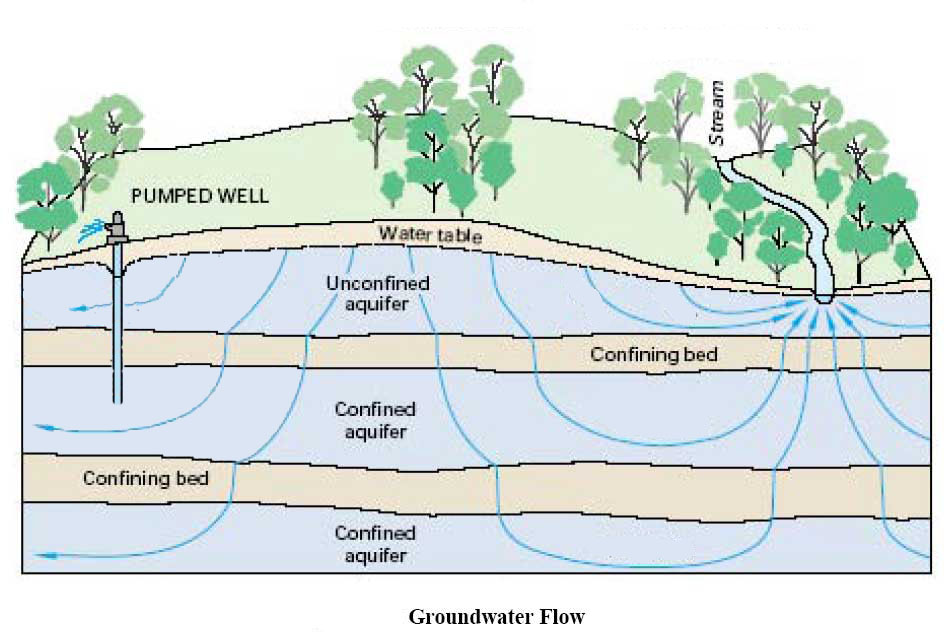GROUNDWATER FAQs

Winter, T.C., Harvey, J.W., Franke, O.L., and Alley, W.M., 1998, Ground Water and Surface Water, A Single Resource: U.S. Geological Survey Circular 1139, 79 p.
Rates of groundwater movement are extremely variable depending on the size of sediment grains through which the groundwater is moving, the topography, and whether or not any wells are withdrawing water in the area.
In locations where wells are actively removing water from the ground, the rate of groundwater movement will be increased because of the withdrawals. The increase in groundwater movement due to well water withdrawal can occur in both vertical and horizontal directions. Groundwater movement, particularly in confined aquifers, can be quite slow. Using the water level information from numerous wells in the region, pumping tests, and information on the physical nature of the sediments which make up the aquifers, a groundwater model was developed for the area. This model indicated that water entering the DMCF and moving downward into the aquifers would take 15 to 25 years to reach homeowners wells in West View Shores (WVS), Bay View Estates (BVE), and Sunset Pointe, as well as the homes along Pond Neck Road adjacent to the DMCF.
The US Geological Survey (USGS) Pearce Creek report summarized that groundwater in the Pearce Creek area moves from relatively higher elevations to lower elevations. In a general sense, groundwater moves from the DMCF downward into the water table aquifer (Matawan and Magothy Aquifers) and subsequently expanding in all directions, outward toward lower elevation areas such as Pearce Creek Lake and the Elk River. The deeper Upper Patapsco Aquifer is partially confined by an intervening clayey sediment layer, which restricts water movement from the water table aquifer to this deeper aquifer. However, near the southwestern side of the DMCF, this confining clay layer is thin or absent allowing water to move into the Upper Patapsco Aquifer. Because many homeowner wells are withdrawing water from the Upper Patapsco Aquifer the rate of downward movement of groundwater is increased.
The liner was completed in spring 2017. The liner was placed on top of the existing sediments within the Pearce Creek DMCF. Installation of the liner isolated the sediments presently in the facility from further introduction of rainwater and surface water. Sediments and water placed above the liner will not be able to enter the groundwater system. This will reduce the rate of movement of groundwater, both horizontally and vertically, and will reduce the future movement of chemicals in the sediments and groundwater below the liner.
CENAP is currently monitoring groundwater in the vicinity of the DMCF using 37 monitoring wells (19 are pre-existing) under an MDE-approved groundwater monitoring plan. Groundwater samples are collected and analyzed for specific conductance, pH, temperature, oxidation-reduction potential, turbidity, and dissolved oxygen. Samples will also be tested for Total Metals (Aluminum, Arsenic, Beryllium, Cadmium, Calcium, Iron, Lead, Magnesium, Manganese, Nickel, Potassium, Sodium, and Zinc), General Chemistry Parameters (Alkalinity, Total Dissolved Solids, Total Suspended Solids, Fluoride, Chloride, Bromide, Sulfate, Nitrogen (nitrite and nitrate), Nitrogen (nitrate), and Nitrogen (nitrite)), and Radiologic Parameters (Gross Alpha and Gross Beta). Lastly, the groundwater monitoring efforts include five (5) piezometers, which are used to measure the pressure of groundwater.
